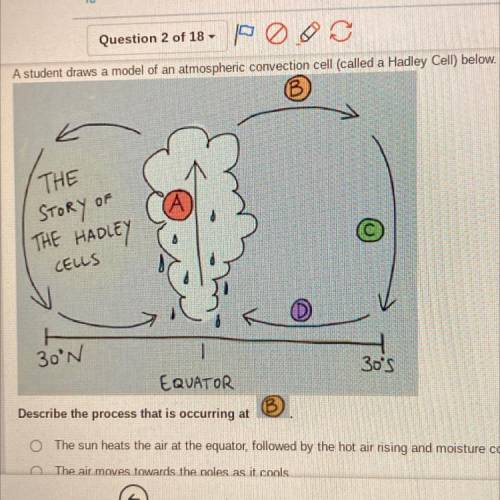
A. The sun heats the air at the equator, followed by hot air rising and moisture condensing
B. Air moves towards the poles as it cools
C. The dry air moves back to the equator, picking up a lot of moisture on the way
D. The air sinks around 30° latitude and is very dry.


Answers: 1
Other questions on the subject: Biology

Biology, 21.06.2019 13:30, davidswafforddd478
Suppose a scientist measures the amount of dna per cell of a particular diploid species at various stages of meiosis. she finds that the meiotic cells contain 3.7 pg , 7.3 pg , or 14.6 pg of dna. match each stage of the cell cycle to the corresponding amount of dna contained within a cell at that stage.
Answers: 3

Biology, 22.06.2019 07:30, queenjade582
Answer ! in your opinion, what are the limiting factors that might affect the growth or diversity of our ecosystem? respond to this question in claim, evidence, reasoning format. 1. make your claim (i are the limiting factors that might affect the growth or diversity of our 2. follow the claim with 3 pieces of evidence. evidence may be taken from the reading, the videos, previous lessons, or googled answers. site sources, too. 3. use reasoning to explain why you chose your evidence.
Answers: 2

Biology, 22.06.2019 10:30, nonjabulomabaso7423
Subduction zones form when an oceanic plate collides with another oceanic plate or continental plate. the continental crust is lighter and less dense than oceanic crust. continental crust's density is approximately 2.7 grams per cubic centimeter. oceanic crust is thinner and the average density is about 3.3 cubic centimeters. when the two crustal plates converge the oceanic plate always bends and subducts beneath a continental plate. once the oceanic crust subjects, the rocks are subjected to changes in heat and pressure. because of this, we would expect to find rocks in the area of a subduction. a) clastic b) igneous c) metamorphic d) sedimentary
Answers: 2

Biology, 22.06.2019 10:40, ari313
Which of the following factors would not contribute to allopatric speciation? a) a population becomes geographically isolated from the parent population. b) the separated population is small, and genetic drift occurs. c) the isolated population is exposed to different selection pressures than the ancestral population. d) different mutations begin to distinguish the gene pools of the separated populations. e) gene flow between the two populations is extensive.
Answers: 2
Do you know the correct answer?
A. The sun heats the air at the equator, followed by hot air rising and moisture condensing
B. Air...
Questions in other subjects:

Social Studies, 11.10.2019 14:00


Social Studies, 11.10.2019 14:00

Mathematics, 11.10.2019 14:00



Mathematics, 11.10.2019 14:00

Chemistry, 11.10.2019 14:00

Biology, 11.10.2019 14:00

Biology, 11.10.2019 14:00






